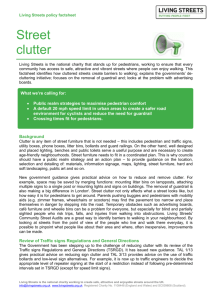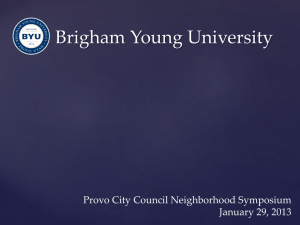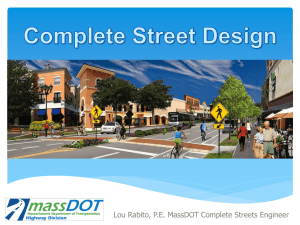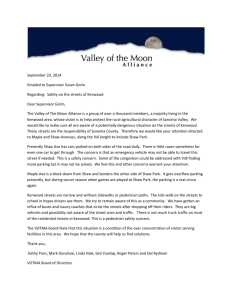Five steps to sustainable *complete streets* for Houston
advertisement
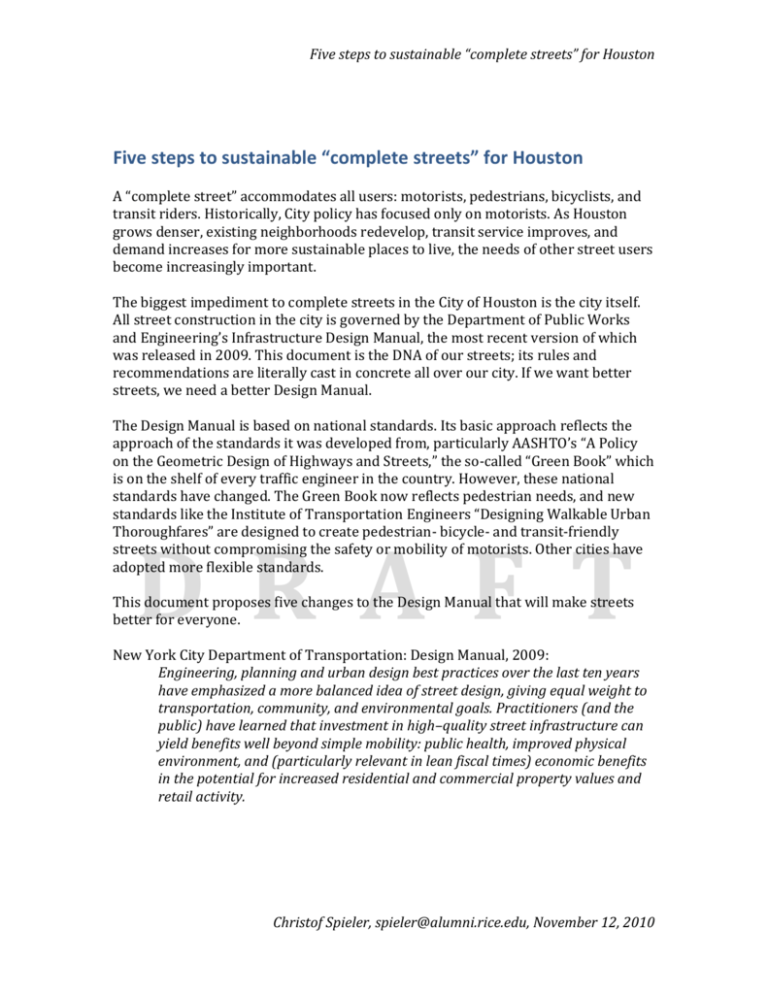
Five steps to sustainable “complete streets” for Houston Five steps to sustainable “complete streets” for Houston A “complete street” accommodates all users: motorists, pedestrians, bicyclists, and transit riders. Historically, City policy has focused only on motorists. As Houston grows denser, existing neighborhoods redevelop, transit service improves, and demand increases for more sustainable places to live, the needs of other street users become increasingly important. The biggest impediment to complete streets in the City of Houston is the city itself. All street construction in the city is governed by the Department of Public Works and Engineering’s Infrastructure Design Manual, the most recent version of which was released in 2009. This document is the DNA of our streets; its rules and recommendations are literally cast in concrete all over our city. If we want better streets, we need a better Design Manual. The Design Manual is based on national standards. Its basic approach reflects the approach of the standards it was developed from, particularly AASHTO’s “A Policy on the Geometric Design of Highways and Streets,” the so-called “Green Book” which is on the shelf of every traffic engineer in the country. However, these national standards have changed. The Green Book now reflects pedestrian needs, and new standards like the Institute of Transportation Engineers “Designing Walkable Urban Thoroughfares” are designed to create pedestrian- bicycle- and transit-friendly streets without compromising the safety or mobility of motorists. Other cities have adopted more flexible standards. D R A F T This document proposes five changes to the Design Manual that will make streets better for everyone. New York City Department of Transportation: Design Manual, 2009: Engineering, planning and urban design best practices over the last ten years have emphasized a more balanced idea of street design, giving equal weight to transportation, community, and environmental goals. Practitioners (and the public) have learned that investment in high–quality street infrastructure can yield benefits well beyond simple mobility: public health, improved physical environment, and (particularly relevant in lean fiscal times) economic benefits in the potential for increased residential and commercial property values and retail activity. Christof Spieler, spieler@alumni.rice.edu, November 12, 2010 Five steps to sustainable “complete streets” for Houston 1. Create standards for conditions with constrained right of way Why this matters: Most of the development in the City of Houston is occurring on existing streets, not in new greenfield plots. Whenever an existing street undergoes a major reconstruction, it is redesigned to current standards. Widening the right of way of an existing street is expensive and is likely to displace homes, business, and historic buildings. In a limited right of way, it becomes necessary to balance different portions of the street. Engineers need guidance for that. Current city standards: Street sections shown in the manual are standards for new greenfield streets with rights of way of 80 to 140 feet for thoroughfares and 50 to 70 feet for local streets. Most existing streets in the city have narrower rights of way. No guidance is provided for narrower rights of way. Recommended new standards: Create a minimum and desired width for all street elements and a set of guidelines for which element to favor when right of way is limited. D R A F T Precedents for new standards: New York City Department of Transportation: Design Manual, 2009: “In a city with as many varied and complex conditions as New York, designs must be tailored for the particular needs and opportunities created by the local context, uses, and dimensions of streets. Therefore, the Street Design Manual leaves ample room for choice, and all designs remain subject to case–by–case NYC DOT approval based on established engineering standards and professional judgment, with the safety of all street users being of paramount importance.” ITE: Designing Walkable Urban Thoroughfares: A Context Sensitive Approach, 2010: “The objectives of this report are to … Describe the relationship, compatibility and trade-offs that may be appropriate when balancing the needs of all users, adjoining land uses, environment and community interests when making decisions in the project development process; … Provide criteria for specific thoroughfare elements, along with guidance on balancing stake- holder, community and environmental needs and constraints in planning and designing walk- able urban thoroughfare projects.” Christof Spieler, spieler@alumni.rice.edu, November 12, 2010 Five steps to sustainable “complete streets” for Houston 2. Minimize lane widths in urban areas Why this matters: In limited right of way, wider lanes mean narrower sidewalks and smaller street trees. Wide lanes increase pedestrian crossing distance. Wide lanes encourage speeding and increase pedestrian mortality. Current city standard: 12 foot lanes (Infrastructure Design Manual p. 10-19 – 10-22). Exceptions are sometimes made. Recommended new standards: Minimum 10 foot lanes, with minimum 11 foot curb lanes on streets with volumes of buses or trucks. Precedents for new standards: AASHTO: A Policy on the Geometric Design of Highways and Streets, 2001: Lane widths may vary from 10 feet to 12 feet. Lane widths of 10 feet should be used in highly restricted areas with little or no truck traffic. Lane widths of 11 feet are used quite extensively for urban arterial street designs. The 12 foot lane widths are most desirable and should be used, where practical, on higherspeed, free flowing principal arterials. Under interrupted flow operating conditions at low speeds (45 mph or less) narrow lane width are normally adequate and have some advantages. (p. 476-477) D R A F T ITE: Designing Walkable Urban Thoroughfares: A Context Sensitive Approach, 2010: “…on the lower-speed urban thoroughfares addressed in this report (tar- get speeds of 35 mph or less), a range of lane widths from 10 to 12 feet on arterials and 10 to 11 feet on collectors is appropriate. On arterials with target speeds below 30 mph, widths in the lower end of the range are appropriate (10 to 11 feet). On collectors with a target speed below 30 mph, a 10-foot lane width may be appropriate unless the following design considerations or other factors warrant a wider lane. Turn lanes that are 10- to 11- feet wide are appropriate in urban areas with target speeds of 35 mph or less.” “Modern buses can be 10.5 feet wide from mirror to mirror and require a minimum 11-foot- wide lane on roadways with 30 to 35 mph target speeds.” NCHRP: Report 330 Effective Utilization of Street Width on Urban Arterials, Transportation Research Board, Washington, D.C., 1990: “Narrower lane widths (less than 11 ft) can be used effectively in urban arterial street improvement projects where the additional space can be used to relieve traffic congestion or address specific accident patterns.” “All projects evaluated during the study that consisted exclusively of lane widths of 10 feet or more resulted in accident rates that were either reduced or unchanged.” Christof Spieler, spieler@alumni.rice.edu, November 12, 2010 Five steps to sustainable “complete streets” for Houston 3. Provide tight curb radii in urban areas Why this matters: Wide curb radii reduce space for pedestrians at intersections, where pedestrians are most likely to linger. Wide curb radii increase pedestrian crossing distance. Wide curb radii encourage speeding and increase pedestrian mortality D R A F T Current city standard: 25 to 40 feet (Infrastructure Design Manual p.10-22) Recommended new standards: 5-15 feet Precedents for new standards: AASHTO :A Policy on the Geometric Design of Highways and Streets, 2001: When pedestrians encounter an intersection, there is a major interruption in pedestrian flow. The sidewalk should provide sufficient storage area for those waigting to cross as well as an area for pedestrian cross traffic to pass (p.99) ITE: Designing Walkable Urban Thoroughfares: A Context Sensitive Approach, 2010: “Drivers of large vehicles expect to be able to negotiate turns easily. In urban areas, however, expectations based on rural and suburban experiences are unreasonable. Intersection users in urban areas will experience delays and conflicts between vehicles, pedestrians and bicyclists. Driver expectations need to shift toward taking turns with other modes and a sense of uncertainty, which creates a slower, vigilant and safer environment.” “In urban centers (C-5) and urban cores (C-6) at intersections with no vehicle turns, the minimum curb return radii should be 5 feet. Christof Spieler, spieler@alumni.rice.edu, November 12, 2010 Five steps to sustainable “complete streets” for Houston A curb return radius of 5 to 15 feet should be used where: 1. High pedestrian volumes are present or reasonably anticipated; 2. Volumes of turning vehicles are low; 3. The width of the receiving intersection approach can accommodate a turning passenger vehicle without encroachment into the opposing lane; 4. Large vehicles constitute a very low proportion of the turning vehicles; 5. Bicycle and parking lanes create additional space to accommodate the “effective” turning radius of vehicles; 6. Low turning speeds are required or desired; and 7. Occasional encroachment of turning school bus, moving van, fire truck, or over- sized delivery truck into an opposing lane is acceptable.” New York City Department of Transportation: Design Manual, 2009: “All roadway corners should be designed with the smallest possible radius that still accommodates the design vehicle and emergency vehicles.” The University of North Carolina Highway Safety Research Center: walkinginfo.org: “One of the common pedestrian crash types involves a pedestrian who is struck by a right-turning vehicle at an intersection. A wide curb radius typically results in high-speed turning movements by motorists. Reconstructing the turning radius to a tighter turn will reduce turning speeds, shorten the crossing distance for pedestrians, and also improve sight distance between pedestrians and motorists. Nearby land uses and types of road users should be considered when designing an intersection so that curb radii are sized appropriately. Where there is an on-street parking and/or bicycle lane, curb radii can be even tighter, because the vehicles will have more room to negotiate the turn. Curb radii can, in fact, be tighter than any modern guide would allow: older and some neo-traditional cities frequently have radii of 3 to 4.6 m (10 to 15 ft) without suffering any detrimental effects.” D R A F T Christof Spieler, spieler@alumni.rice.edu, November 12, 2010 Five steps to sustainable “complete streets” for Houston 4. Provide marked pedestrian crossings at all intersections, signalized or unsignalized, and allow midblock crossings Why this matters: Pedestrians move slowly compared to cars or bikes, so a small detour can be a major impediment. Intersections with no crosswalks send a clear signal that pedestrians are not welcome. Current city standard: Infrastructure Design Manual p.10-12: “Mid-block crosswalks are not permitted without approval by City Engineer. The specific conditions which warrant a mid-block crosswalk must be provided to support the request for a design variance.” The city also does not mark crosswalks at any location that does not have a stop sign or traffic signal, even though it is legal for pedestrians to cross at these locations. D R A F T One outcome of this policy is that pedestrians will be able to cross the new light rail lines only where traffic signals are being installed. To keep through traffic moving, these signals are often widely spaced. On the East End Line, for example, there will be no signals and thus no pedestrian crossing between Milby and Eastwood, a distance of ½ mile. This could mean a 10 minute walk simply to cross the street. Other cities provide unsignalized crossings in similar loctaions. Recommended new standards: Mark crosswalks at all intersections. Provide midblock crosswalks where blocks pedestrian activity is heavy and blocks are over 400 feet long. Provide crosswalks at every intersection on transit streets, even if vehicle movements at that intersection are restricted. Precedents for new standards: AASHTO: A Policy on the Geometric Design of Highways and Streets, 2001: Christof Spieler, spieler@alumni.rice.edu, November 12, 2010 Five steps to sustainable “complete streets” for Houston Pedestrians tend to walk in a path representing the shortest distance between two points. Therefore, crossings in additions to those at corners and at signalized intersections may need to be provided. (p.96) The number of pedestrian crossings on heavily travelled arterials should be kept to a minimum,, but in an near developed areas it is usually appropriate to provide crosswalks at every intersecting street. (p.489) ITE: Designing Walkable Urban Thoroughfares: A Context Sensitive Approach, 2010: “Generally, however, consider providing a marked midblock crossing when protected intersection crossings are spaced greater than 400 feet or so that crosswalks are located no greater than 200 to 300 feet apart in high pedestrian volume locations, and meet the criteria below. Avoid elimination of any travel modes due to intersection design. (p. 177) Common engineering practice is to exclude marked crosswalks from intersections without traffic control approaching the crossing. This is due to a number of factors including avoiding a false sense of security provided by crosswalks when traffic is uncontrolled, encouraging pedestrian caution when legally crossing at intersections without crosswalks, as well as raising liability and maintenance concerns. Indeed, several research studies have shown that pedestrian-vehicle crash rates are higher at unsignalized intersections with marked crosswalks versus those without.” D R A F T Christof Spieler, spieler@alumni.rice.edu, November 12, 2010 Five steps to sustainable “complete streets” for Houston 5: Increase sidewalk widths Why this matters: Pedestrian activity is key to successful urban neighborhoods, retail districts, and employment centers. Sidewalks need to be wide enough to accommodate all users, including the handicapped and parents with strollers. Absent good sidewalks, pedestrians may be forced to walk in the street, endangering their safety. A wide sidewalk encourages leisurely strolling in groups, helping support street front businesses. D R A F T Current city standard: Infrastructure Design Manual: A minimum 8 foot pedestrian realm including a 5 foot sidewalk. (drawing 02775-01 and p. 10-19 to 10-23 and p.10-32 to 10-42) Infrastructure Design Manual: On transit streets and “A” streets: (1) Minimum Sidewalk Width – 6 feet (must be located within the public right of way). (2) Minimum Vertical Clear Zone, a continuous obstacle free path, for a minimum width of six feet and a minimum height of seven and one-half feet. On METRO’s current light rail lines, a 6 foot pedestrian realm (all paved, with a 4 foot clear zone) has been permitted. Christof Spieler, spieler@alumni.rice.edu, November 12, 2010 Five steps to sustainable “complete streets” for Houston Recommended new standards: 6 foot paved pedestrian clear zone with no obstructions. 10 foot minimum from curb to property line, with 15 foot desired. Precedents for new standards: ITE Designing Walkable Urban Thoroughfares: A Context Sensitive Approach, 2010: Recommended clear pedestrian throughway zone minimum width in constrained conditions is 5 feet in residential and 6 feet in commercial areas (see Table 5.2 in Chapter 5). For very high pedestrian volume areas, such as subway exits, transit transfer points and assembly arena entrances and exits, additional width and special design attention, particularly at crossings, should be provided. USGBC LEED for Neighborhood Development, 2009: New sidewalks, whether adjacent to streets or not, must be at least 5 feet wide on residential blocks or 10 feet wide on non-residential or mixed use blocks. D R A F T Christof Spieler, spieler@alumni.rice.edu, November 12, 2010
